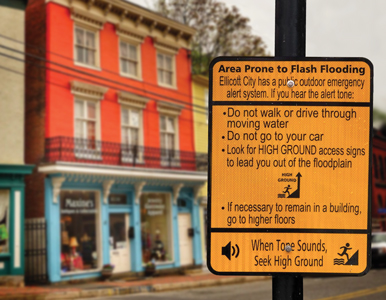
In May 2018, nearly two years after a flash flood devastated Ellicott City, Maryland, a historic town on the edge of the Patapsco River, county government officials prepared to publicly release an ambitious watershed master plan to improve flood resilience, protect buildings, and revitalize the local economy.
Just before the planned announcement, a second “thousand-year rainfall” struck, tearing away sewer connections and causing stream channel retaining walls to tumble. Officials quietly shelved the flood resilience plan, Ken Conca, a professor of environment, development, and health in the School of International Service, writes in his new book, After the Floods: The Search for Resilience in Ellicott City.
Conca, who’s spent his career studying water as “a basic need, a human right, a disruptive force, a source of conflict, and a bridge for peacebuilding,” lived in Ellicott City, four miles from downtown, during the 2016 flood. He’s authored 11 previous books.
After the Floods is a cautionary tale about the efforts of Ellicott City residents, business owners, environmentalists, and developers to reach consensus on how to manage the town’s flood risk after the disasters. Each flood killed two people, destroyed or damaged scores of buildings, and caused economic losses in the tens of millions of dollars.
How to prepare for future floods divided the town. Residents debated whether to build costly underground tunnels to disperse water and batted around the idea of tearing down historic buildings in the commercial district.
“Ellicott City was a town that had many advantages—affluent county, open government, a history of participatory decision-making, access to technical expertise,” Conca says. “I thought if ever there was a community who had a chance to get it right, it would be Ellicott City.”
But after the second flood, what ensued was “bitter conflict, divisiveness, the rise of many extreme solutions being proposed,” Conca adds. The response shows that “even communities with many advantages are going to struggle through a very difficult conversation.”
Conca’s book ends with nine recommendations for learning from Ellicott City’s experience. They include building capacity for conflict resolution, talking practically and accessibly about climate change, and becoming an activist.
One person explained the rationale for activism around flood risk simply: “Because it’s coming.”